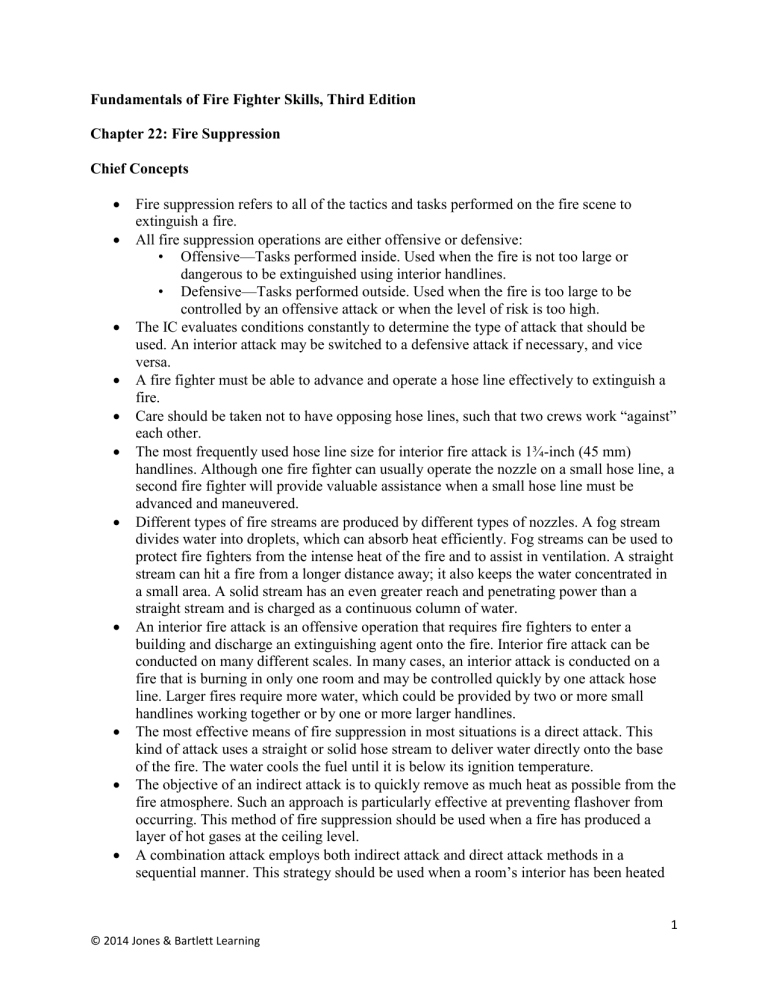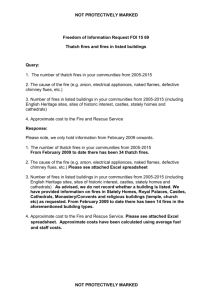Chapter 22 - Fundamentals of Fire Fighter Skills, Third Edition

Fundamentals of Fire Fighter Skills, Third Edition
Chapter 22: Fire Suppression
Chief Concepts
Fire suppression refers to all of the tactics and tasks performed on the fire scene to extinguish a fire.
All fire suppression operations are either offensive or defensive:
•
Offensive—Tasks performed inside. Used when the fire is not too large or dangerous to be extinguished using interior handlines.
•
Defensive—Tasks performed outside. Used when the fire is too large to be controlled by an offensive attack or when the level of risk is too high.
The IC evaluates conditions constantly to determine the type of attack that should be used. An interior attack may be switched to a defensive attack if necessary, and vice versa.
A fire fighter must be able to advance and operate a hose line effectively to extinguish a fire.
Care should be taken not to have opposing hose lines, such that two crews work “against” each other.
The most frequently used hose line size for interior fire attack is 1¾-inch (45 mm) handlines. Although one fire fighter can usually operate the nozzle on a small hose line, a second fire fighter will provide valuable assistance when a small hose line must be advanced and maneuvered.
Different types of fire streams are produced by different types of nozzles. A fog stream divides water into droplets, which can absorb heat efficiently. Fog streams can be used to protect fire fighters from the intense heat of the fire and to assist in ventilation. A straight stream can hit a fire from a longer distance away; it also keeps the water concentrated in a small area. A solid stream has an even greater reach and penetrating power than a straight stream and is charged as a continuous column of water.
An interior fire attack is an offensive operation that requires fire fighters to enter a building and discharge an extinguishing agent onto the fire. Interior fire attack can be conducted on many different scales. In many cases, an interior attack is conducted on a fire that is burning in only one room and may be controlled quickly by one attack hose line. Larger fires require more water, which could be provided by two or more small handlines working together or by one or more larger handlines.
The most effective means of fire suppression in most situations is a direct attack. This kind of attack uses a straight or solid hose stream to deliver water directly onto the base of the fire. The water cools the fuel until it is below its ignition temperature.
The objective of an indirect attack is to quickly remove as much heat as possible from the fire atmosphere. Such an approach is particularly effective at preventing flashover from occurring. This method of fire suppression should be used when a fire has produced a layer of hot gases at the ceiling level.
A combination attack employs both indirect attack and direct attack methods in a sequential manner. This strategy should be used when a room’s interior has been heated
1
© 2014 Jones & Bartlett Learning
to the point that it is nearing a flashover condition. Fire fighters first use an indirect attack method to cool the fire gases, then make a direct attack on the main body of fire.
Large handlines can be used either for offensive fire attacks or for defensive operations.
Master stream devices are used to produce high-volume water streams for large fires.
Several types of master stream devices exist, including portable monitors, deck guns, ladder pipes, and other elevated stream devices. Most master streams discharge between
350 (1591 lpm) and 1500 (6819 lpm) gallons of water per minute.
Fires in ordinary and wood-frame construction can burn in combustible void spaces behind walls and under subfloors and ceilings.
Fires in basements or below grade level may cause the floor on the ground level to collapse.
Protect stairways and other vertical openings between floors when fighting a fire in a multiple-level structure. Hose lines must be placed to keep the fire from extending vertically and to ensure that exit paths remain available to fire fighters and victims.
Many large buildings have floor plans that can cause fire fighters to become lost or disoriented while working inside, particularly in low-visibility or zero-visibility conditions.
Buildings that are under construction, renovation, or demolition are all at increased risk for destruction by fire. These buildings often have large quantities of combustible materials exposed, while lacking the fire-resistant features of a finished building.
A lumberyard fire will usually produce tremendous quantities of radiant heat and release burning embers that can cause the fire to spread quickly from stack to stack.
Fires in stacked materials should be approached cautiously. All fire fighters must remain outside potential collapse zones. Mechanical equipment should be used to move material that has been partially burned or water soaked.
Fires in trash containers may be fought with foam or a deck gun.
Some unique hazards exist with fires in confined spaces, including oxygen deficiencies, toxic gases, and standing water.
Vehicle fires are one of the most common types of fires handled by fire departments.
These fires may result from a variety of causes, including discarded smoking materials, electrical short-circuits, friction caused by dragging brakes or defective wheel bearings, and ruptured fuel lines due to a collision.
Many hazards related to vehicle fires are possible— traffic hazards, fuel, pressurized cylinders and containers that can explode, fire, and toxic smoke.
Overhaul of vehicle fires is just as important as overhaul of structure fires. As soon as it is safe to approach the vehicle, chock the wheels to prevent the vehicle from moving.
After all visible fire has been knocked down, allow a few minutes for the steam and smoke to dissipate before starting overhaul. As you overhaul the vehicle, be systematic and thorough.
Always be alert for signs that a burning vehicle could be powered by an alternative fuel, such as compressed natural gas (CNG) or liquefied petroleum gas (LPG). Fully involved fires in vehicles powered by either type of fuel should be fought with an unmanned master stream to prevent injuries from exploding gas cylinders.
Flammable-liquid fires can be encountered in almost any type of occupancy. Most fires involving a vehicle (e.g., airplane, train, ship, car, truck) will involve a combustible or
2
© 2014 Jones & Bartlett Learning
flammable liquid. Special tactics must be used when attempting to extinguish a flammable-liquid fire, and special extinguishing agents such as foam or dry chemicals may be needed.
Flammable-gas cylinders can be found in many places. Many types of flammable gases are stored in many different types and sizes of containers. A variety of flammable gases can be found in industrial occupancies.
The greatest danger with propane and similar flammable-gas products is a BLEVE. If an
LPG tank is exposed to heat from a fire, the temperature of the liquid inside the container will increase. The fire itself could be fueled by propane escaping from the tank or from an external source. As the temperature of the product increases, the vapor pressure will increase in tandem. The increasing pressure creates added stress on the container. If this pressure exceeds the strength of the cylinder, the cylinder can rupture catastrophically.
The greatest danger with most fires involving electrical equipment is electrocution. Only
Class C extinguishing agents should be used when energized equipment is involved in a fire. All electrical equipment should be considered as potentially energized until the power company or a qualified electrical professional confirms that the power is off.
Once the electrical service has been disconnected, most fires in electrical equipment can be controlled using the same tactics and procedures as are used for Class A fires.
© 2014 Jones & Bartlett Learning
3




